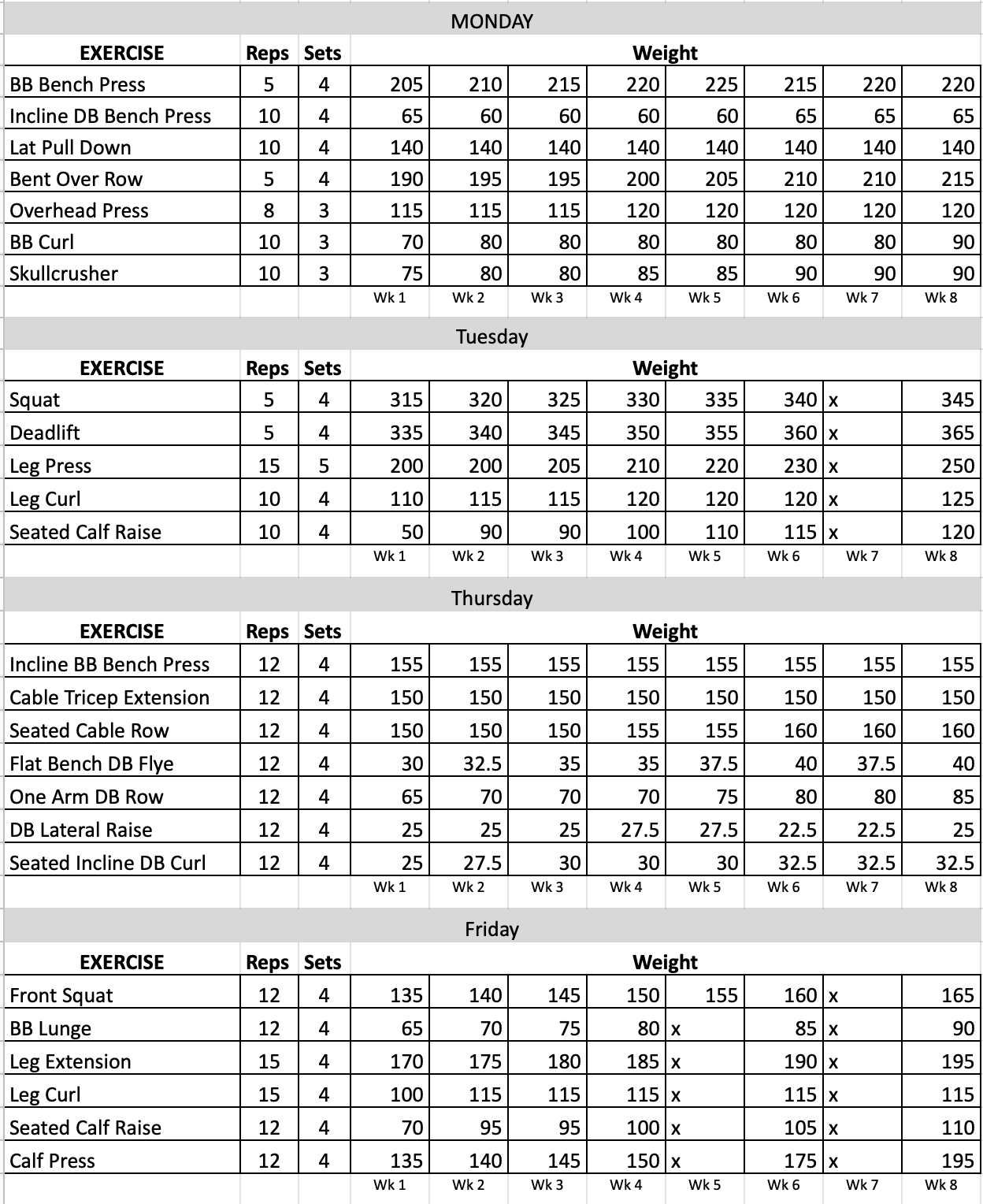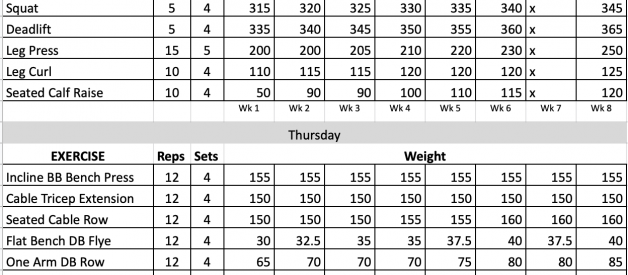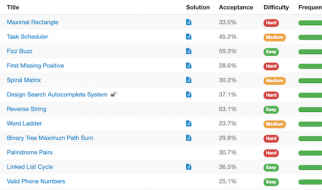Back sooner than normal for a look at my first non-5/3/1 review on this Medium. This my first time stepping outside of Jim Wendler?s popular program in two years and I did Power Hypertrophy Upper Lower by Brandon Campbell for the prescribed eight weeks.
After programming almost exclusively around Jim Wendler?s philosophy for years, I decided to go for something different with P.H.U.L. The program falls under the trend/portmanteau of ?powerbuilding,? a combination of powerlifting and bodybuilding. While the term is relatively new, the idea of using bodybuilding to help powerlifting (and using powerlifting to help bodybuilding) is not.
There?s some powerlifting here, so it makes a little sense to talk about 1RM movement. But I didn?t test my 1RM, nor do I plan on it. This makes talking about the strength aspects of it a little tough, but I end this program just exhausted and sore, I don?t feel I would get a true 1RM until after at least a week?s rest and then another week to test 1RM and I?d honestly just do a deload week and get back into training more than test.
That said, I honestly expect a bit of regression in strength because of the complete lack of volume I had on the big four. I went from a 5/3/1 anchor (God is a Beast) that had 33+ reps a week for each of the big 4 to, at most, 20 reps a week on bench, squat and deadlift and only 18 on overhead press. So, I?ll simply assume regression occured.
What is Power Hypertrophy Upper Lower?
From the horse?s mouth:
Build both size and strength in this 4 day split based around basic compound movements. Get the best of both worlds with bodybuilding and powerlifting.
That is, while P.H.U.L. employs a lot of big, compound powerlifting movements, it?s still a split program. And that?s both in the traditional sense, e.g. splitting up parts of the body and working them on different days, and in a different sense, e.g. splitting up ?power? exercises and ?hypertrophy? exercises.
This is uncharted territory for me. The three programs I used up to this point, 5/3/1, Stronglifts and Greyskull LP all eschewed the split idea in programming. While some vanilla 5/3/1 templates did split things out a bit, Forever style 5/3/1 almost always has assistance work that hits a push, a pull and a leg workout, resulting in no day ever splitting.
For the other split, P.H.U.L. has ?power? days, days ostensibly for doing more compound lifts at higher weight, lower rep ranges. But even those days have many exercises done in the hypertrophy range after you get past the compound lifts. On lower power day, for example, 4×15 leg presses are the third exercise done. Stuff run in the ?power? range of 3?8 reps (depending on the actual lift) were bench, overhead press, barbell row (I did Pendlay Rows myself), back squat and deadlift. Those should sound familiar to anyone that?s run a 5×5 program like Stronglifts.
So, the split covers four days total: 1 of each, upper and lower, power and then 1 of each, upper and lower, hypertrophy.
While you don?t run each exercise to failure, there isn?t a built in emphasis on any movements. In 5/3/1, Wendler puts big emphasis on the big four and cares so little about accessory movements that he doesn?t even tell you which specific ones to do, just how many reps and sets. This was a big change for me after two years in Wendler land. I burned way more calories per workout, giving each exercise a ?focus? of sorts. I also felt it physically, I was just as worn down from upper hypertrophy days I was from say, squat days, in 5/3/1, which used to be my baseline for ?demanding.?
I supersetted a lot of the program to keep it moving, and even while doing that, I often spent 80 minutes from first lift to last.This also meant re-arranging the order of the exercises a bit to fit in with my gym?s layout; I put stuff that was easy to super set without walking across the gym (and holding equipment from across the gym is something I like to avoid as well).
Because there is absolutely no ab work in the program, the author does say to do ab work on your own, outside the gym. This works well with what I do anyway, which is: ab work on my days outside the gym. I could see this being a bit annoying for some people, who just want the program to begin and end at the gym and not bleed over into other parts of their life.
The loading of this program is by far the biggest change up for me. No longer is there an algorithm that takes in my training max and tells me what to lift. Instead, I simply did work and if it felt easy, then I put more weight on the next week. If it felt too hard, I took some off. If it felt right, I didn?t change it. That?s the basic idea anyway. I have to admit, I?m not sure if I handled this aspect of the program correctly.
There?s no deloads in the program, and I feel that?s a mistake. Going all out on every exercise for 8 weeks straight is tiring and by week 8 I was exhausted and had insane DOMS in my quads. If I was to recommend this program to anyone, I would tell them to put a deload week of running everything at around 50% between weeks 4 and 5 just to break it up a bit and give the body a chance to recover.
But also, I?m in my upper 30s and do not recover like I used to.
My Lifting Background Up to This Point
I have been program lifting for almost four years. First six months were Stronglifts 5×5, then a year of Greyskull LP (during which I injured my back and spent months in recovery, losing a lot of deadlift and squat progress). I started 5/3/1 in February of 2017, switching to Forever style programing in February of 2018. 2019 I started various powerbuilding programs.
Before that, I had been on fuckarounditis for two years of varying intensity and absolutely no progression plan in an apartment building gym similar to a hotel level gym. I spent my 20s largely an out of shape obese guy after being an athletic teenager.
Work Outside of the Gym
During this program, I continued to take a creatine supplement of 5g a day. I also continued taking a daily D3 5,000 IU vitamin supplement and Fish Oil for Omega-3 1000 mg daily.
I have eschewd calorie counting for about half a year now. I have a good idea of what goes in and out of me thanks to previously calorie counting though. So, I?m not flying blind, but I?m not bothering plugging numbers into a tracker these days. That said, I put on a little too much weight during this program. A half a pound a week is fine to lose, but gaining that fast was probably not a great idea. That said, it?s obvious I had a calorie surplus based on that weight gain, so that definitely did not contribute to how much the program ground me down.
This program has no required cardio, so my weighted vest stayed in my closet. I walk, on average, 2.5 miles a day while pushing my 35 pound toddler around in a stroller, that?s my cardio. As the weather has gotten nicer, I?ve walked more, often chasing that same toddler as he takes his scooter around the neighborhood. Because I suffer from asthma, I can?t really do anything much more demanding than that anyway, so I really didn?t reduce my cardio work too terribly much.
On days not at the gym, I continued my ab focused routine that I?ve been doing all through my 5/3/1 days. This is 15?30 minutes of ab roller, leg raises and push-ups with some stretching as well. This isn?t to get good abs for aesthetics, but a hold over from my physical therapy after I screwed up my back. My chiropractor noticed my core was very weak and was forcing too much work on my back and was probably a big contributing factor to the strain I suffered.
Impressions of the Program
This shit is tough.
When I was doing 5/3/1, there would be days I would only burn 250?300 calories at the gym (usually overhead press days). But last year on squat days, I was up at about 500?600. In this program, all movements are treated as equal, so I found myself pushing myself on each one. The result was about 600 calories burned every day at the gym, regardless of the specific exercises that day.
That said, even while I was burning more, I was eating even more. I somehow gained weight during this whole process. Plus, I almost always get eight hours of good sleep a night. So, with good diet and rest, I still got a bit destroyed by giving my all to literally every lift in the program rather than focusing on say just compounds or something.
The first couple of weeks was a lot of my body just getting used to the shock of the increased intensity. Especially doing heavy deadlifts right after heavy squats. That was about as demanding in real life as it looked on paper. But while there was a point where my body was used to the intensity and not yet burned down, I did eventually flame out. This program is too demanding to not have a deload week somewhere.
Part of the high intensity was probably me over compensating for the loading on this program; I wanted to make sure I did not do too little weight. When the algorithm tells me what to load, I can accept it as gospel from outside of me that it is pushing properly. But this program required me to be introspective and ask myself if I was able to finish easily or not. I didn?t want ?cheat? by saying a lift was too hard when it wasn?t, so I really pushed myself to add weigh to all workouts whenever I could.
The result, at least for the big four, was running at about 70%-80% of my 1RM or so for 4×5 (or 3×8 for overhead press). Much heavier than my 5/3/1 days, where I would run the easiest lifts at 65% of 85% of my 1RM and even the hardest days would be one set at 85%. This, of course, makes 5/3/1 more sustainable long term, whereas after eight weeks of P.H.U.L., I am definitely ready for a break.
I tried to take some of that mental responsibility of choosing how heavy to go off my hands and came up with a sort of algorithm (of course!). The way loaded was simple, I looked at the rep ranges prescribed in the program for each exercise. If I hit the max number of reps in every set that day, it was ?easy,? and I should up the weight. If I failed hit the minimum number of reps on any set, it was ?hard? and I should lower the weight. If I just hit inside the rep range, it was normal and I should leave the weight where it is.
I don?t know if this was the best way to do it, but it was the easiest way to not have to ask myself too many questions about how I perceived the challenge to be. For some movements, this worked well. I slowly added weight to the bar on squat and deadlift throughout the program. But for others, most notably my incline barbell bench press, I never moved the weight all eight weeks in either direction. This lead me to believe that I didn?t have the best system in place; surely my incline bench should have had some sort of movement in that system if it was effective.
For a detailed look at what moved and what didn?t, here?s my workout log:
 Note: cable triceps extensions never moved because that?s the heaviest the machine at my gym goes.
Note: cable triceps extensions never moved because that?s the heaviest the machine at my gym goes.
Part of thinking about ?progress? in this program though, is thinking about starting weight. It?s easy to ?progress? for eight weeks if you start light. The biggest indicator of that is the calf exercises. As I mentioned, I hadn?t done those since high school, so it was real guess work as to what weight I should run those at and so I went fairly low and found myself ?progressing? quite fast when in truth I was just finding where I should actually be.
And perhaps my desire for those bigger arms saw me starting my upper lifts too heavy while having a good starting spot for my lower lifts. But regardless, my lower lifts advanced very well while my upper lifts, especially on hypertrophy days, barely moved. While eight weeks is way too short of a time to expect major movement, especially at my level when linear growth is unsustainable at best, I would have still expected every exercise to move at least once.
One thing this program taught me was that I was doing a lot of assistance work in 5/3/1 way too light. Stuff like skullcrushers, leg curls and single arm rows were a staple of my 5/3/1 work for most of the last year and it?s clear I could have been going much heavier based on the progress I had during this program. As much as I don?t want to bring everything back to 5/3/1 too much, I have to admit that this program showed me that I may have disregarded the assistance work a little much. Jim is pretty blah on that work in almost everything he writes, so part of it is me taking him too seriously on that. But doing a program based 100% on feel has probably helped me figure out what?s heavy enough in a situation where there isn?t a formula telling me how to load.
Here is a good place to point out my biggest sin against the program: skipping leg day. Hence those ?x? marks up there. I missed more days on this than I have in any recent program I can think of. Just a lot of things conspiring against me: getting sick, bad weather, child being too disagreeable to stay in the gym day care all happened, sometimes immediately after each other. It sucked, but I missed one leg power day and 1.8 leg hypertrophy days.
But this leads me to my first major criticism of this program: leg hypertrophy day seems unnecessary. At the rep ranges it had especially: 12 barbell lunges, so 12 reps per leg, 24 reps total, x 4 sets is barely a strength activity. It was a cardio day more than anything else. Part of the reason I missed these days is because they felt wholly unnecessary and so when something came up, it was much easier to say, ?just stay home and recover from this cold? or ?just take the kid home and save the poor women in the day care.?
And, this is now specific to me, but my legs are already huge and I have never trained for leg size. I have 25 inch thighs, which is an inch bigger than bodybuilder Layne Norton, who clocked in at 30 lbs more than me, was after at least 5 years of training according to him. To put it another way: I wear Levi?s 541 cut jeans and my thighs are so big they literally destroy these jeans specifically designed for men with an average waist but huge, in relation, thighs.
But to pull this out to more average people without t-rex body shapes: many bodybuilders don?t really build legs. Many bodybuilding competitions are upper body focused to a fault.
So, while it?s good not to look like a google image search for ?skip leg day,? those cases are extreme and definitely do not apply to me and, I?m guessing, probably don?t apply to a lot of people. While my calves, like most people?s, could be a bit bigger, there?s hypertrophy calf work on leg power day. In fact, the only stuff run at ?power? level reps/sets are squats and deadlifts. The rest of the leg ?power? day is 4×10 and 5×15(!), so? leg hypertrophy day just seems like a waste of gym time.
Further complicating that was that my general consensus, and the consensus of those I asked, was that my upper arms, the holy grail of aesthetic muscles to many, are still small. Part of this, I think, comes from the fact that direct triceps and biceps work is done at the end of both upper days, meaning when I was most exhausted and therefore too tired to do more demanding work on them. But I think a bigger problem was just lack of volume.
So, for me personally, spending time making my thighs even bigger while not getting any real progress on my triceps or biceps aesthetically was pretty defeating out of a program that has, at least as half its mission, better aesthetics. Aesthetics are obviously personal, but come on, who doesn?t want bigger arms? And how many folks do you hear talk about wanting bigger thighs? It seems like a basic design on a program should take into account what?s ?in? aesthetically if it?s built for aesthetics.
That said, my yolk got even better, traps, delts and shoulders responded very well to P.H.U.L. My back, overall, looks really great these days. I have a solid curve from my glutes up in through my spinal erectors and back out starting at my lats. My thighs have always been rock hard and are now literally destroying my pants, so if you want bigger thighs, you?ve come to the right place. This was the first time I did direct work on my calves since high school, and it showed. My forearms continued to look great, so no complaints there either.
And, while I didn?t test my 1RM, like I said, I dropped volume like crazy on those and can?t expect them to have gotten better.
The end result is rather than a best of both powerlifting and bodybuilding worlds, I seem to have gotten neither.
Conclusion
It felt very good to get outside of powerlifting and Jim Wendler for a bit. To see a different type of training from a different philosophy with a different structure. While I obviously struggled with how to handle loading with this, that?s more a revelation of weak point in my training knowledge than a knock on the program. But I do think this program spends too much time with legs, especially for a program that ostensibly is about aesthetics.
But after all was said and done, I had a hard time figuring out who this program is for. Beginners probably need this sort of full body, hit everything, type routine because they can literally improve throughout their body. But this has so many movements to learn and no loading strategy outside of feel, that I wouldn?t recommend it to any beginner over Greyskull LP. Advanced lifters, on the other hand, probably have a good idea of what they need to focus and would not need a program that tries to be a little bit of everything and instead ends up being not enough of anything.
Overall: Not Recommended
Unless you?re looking for a lark, I just don?t see any reason to bother with this program. I was, so I?m not all that salty about it being what it is.
Where to next for me? I?m going to look at the other side of the powerbuilding coin: P.H.A.T is my next stop. Developed by Layne Norton, P.H.A.T. is a five day a week program somewhat similar to P.H.U.L. (I mean, the names are almost identical), but goes five days a week and has way more volume because of that extra day. P.H.A.T and P.H.U.L. are often compared, so I?d like to make my own comparison between the two.
I?ve never done more than four days a week, so I am interested to see how my body reacts to probably the biggest change in programming I?ve done in my life. P.H.A.T. also has absolutely no conventional deadlifting in it. So, a big departure from my normal programming, but I am treating 2019 as a year for really changing my views on lifting, so let?s see how it goes.
For now, the plan is to try to fit that fifth day into my schedule. I?d like to do a true comparison between P.H.U.L. and P.H.A.T. But, if one day has to go, it?ll be, you guessed it, leg hypertrophy day.
Now excuse me, I gotta go buy some new pants.


